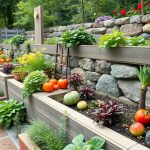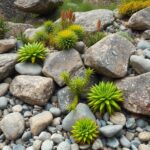When it comes to designing a landscape that thrives in dry conditions, there are plenty of smart and stylish ways to approach it. This guide will explore 23 drought-tolerant landscape designs that not only save water but also elevate the beauty of your outdoor spaces. From native plant selections to creative hardscaping, you’ll discover how easy it can be to create a sustainable garden that’s both practical and eye-catching.
Incorporating Hardscapes to Reduce Water Needs
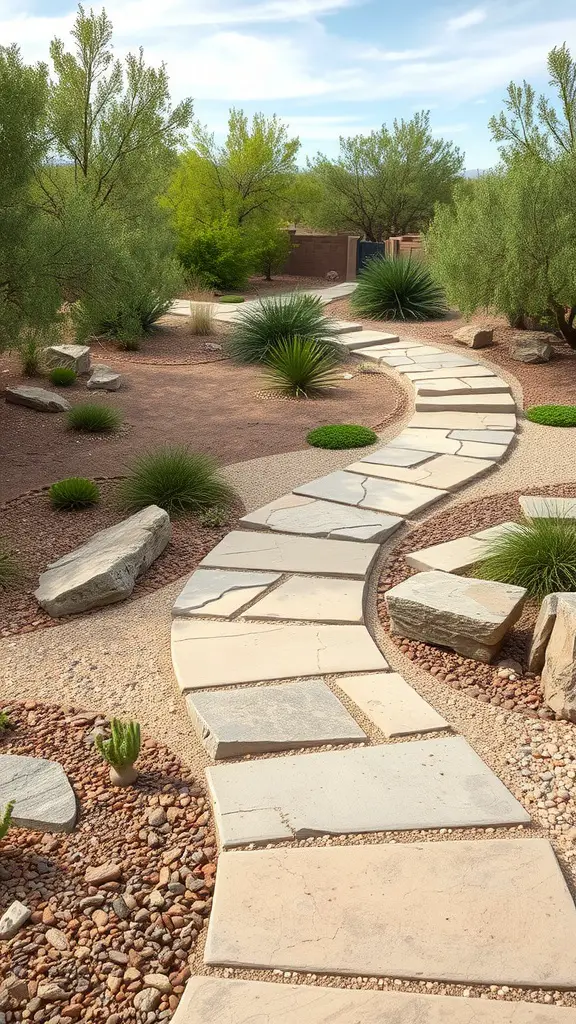
When designing a drought-tolerant landscape, hardscapes play a key role in conserving water. The image illustrates a winding pathway made of stone pavers, surrounded by carefully placed native plants. This blend of materials not only adds visual interest but also minimizes the areas that require watering.
Using stones and gravel helps in reducing soil erosion and allows rainwater to soak into the ground effectively. The pathway invites you to explore the landscape while keeping maintenance low and water usage minimal. Plants like succulents and drought-resistant shrubs complement the hardscape by requiring less water.
Incorporating features like patios, walkways, and rock gardens can create beautiful outdoor spaces. These elements reduce the overall need for grassy areas that consume more water. By choosing the right materials and plants, you can create a landscape that thrives in dry conditions.
Incorporating Native Plants for Drought Resistance

Incorporating native plants in your landscape design can significantly enhance drought resistance. The image showcases a beautiful arrangement of various native plants, highlighting their diverse shapes and colors. These plants are well-adapted to local climates and require less water compared to non-native species.
Notice the striking purple flowers standing tall among the green foliage. These plants not only add aesthetic appeal but also attract local pollinators, contributing to the ecosystem. The use of mulch in the design helps retain moisture in the soil, further supporting the growth of drought-tolerant plants.
When selecting native plants, consider those that thrive in your specific region. They often have deep root systems that access water below the surface. This characteristic allows them to survive longer periods without rainfall, making them an excellent choice for sustainable landscaping.
In addition to being drought-resistant, native plants can create a low-maintenance garden. With the right selection, you can enjoy a vibrant landscape while conserving water and supporting local wildlife.
Utilizing Mulch to Conserve Soil Moisture
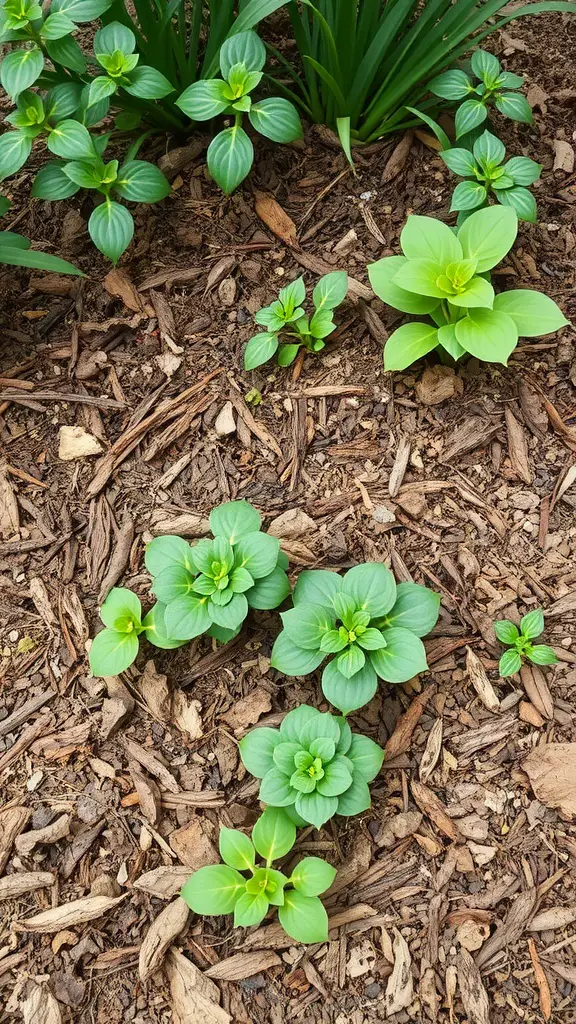
Mulch is a simple yet effective tool for maintaining soil moisture in drought-tolerant landscapes. In the image, you can see a variety of vibrant green plants surrounded by a layer of organic mulch. This mix not only looks good but serves a crucial purpose.
By applying mulch, you can help retain water in the soil, reducing the need for frequent watering. The mulch layer acts as a barrier, slowing down evaporation and keeping the roots cool. Additionally, it prevents weed growth, which can compete for water and nutrients.
In a drought-tolerant landscape, using mulch helps create a more sustainable garden. It encourages healthy plant growth while conserving resources. Pairing mulch with drought-resistant plants, like the ones in the picture, creates an attractive and efficient space that thrives with minimal water.
Choosing Perennial Plants for Longevity

When designing a drought-tolerant landscape, selecting the right perennial plants is key to ensuring a vibrant garden that lasts through the seasons. In the image, you’ll see a colorful mix of flowers and foliage that thrive in dry conditions.
The bright yellows, reds, and purples of the flowers add a lively touch to the landscape. These colors not only create visual interest but also attract pollinators, which are essential for a healthy garden. The plants here are well-suited for areas with limited water, making them ideal choices for drought-prone regions.
Perennials, unlike annuals, return year after year, requiring less maintenance and saving you time and effort. This photo showcases a variety of species that can handle the heat and still look vibrant. When selecting your plants, look for those known for their resilience and ability to withstand dry spells.
Incorporating plants like these can create a stunning, low-maintenance design while also being environmentally friendly. So, as you plan your garden, think about the long-term benefits of choosing perennials that can thrive on minimal water.
Implementing Rain Gardens for Stormwater Management
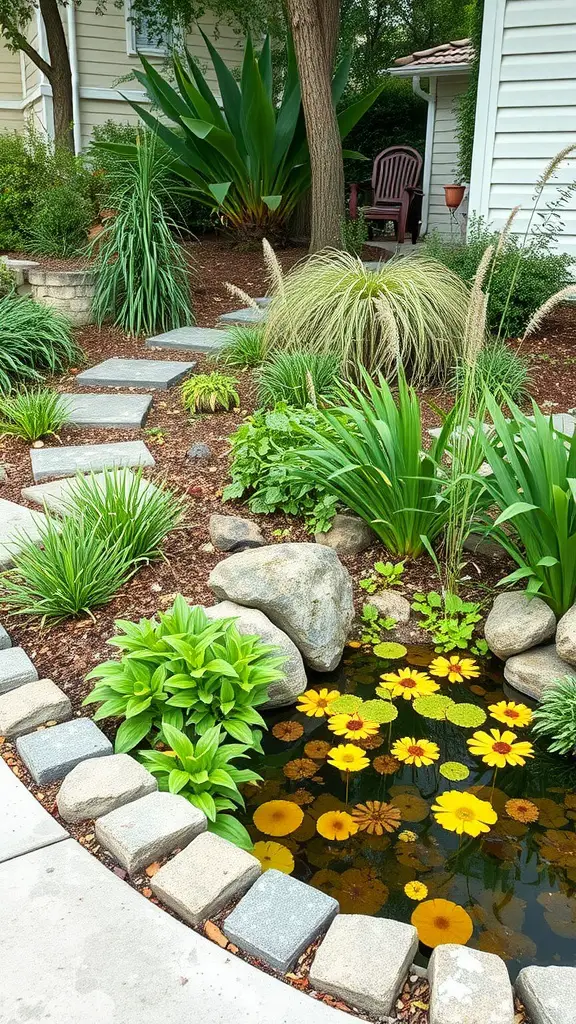
Rain gardens are a smart way to manage stormwater while adding beauty to your landscape. The image showcases a well-designed rain garden, nestled between vibrant plant life and a charming pond. This setup not only captures rainwater but also provides a habitat for local wildlife.
The use of native plants, as seen around the pond, is key in a rain garden. These plants are often more drought-tolerant and can thrive with less water. The lush green foliage adds texture and color, making the garden inviting.
Incorporating stones around the pond helps with drainage and gives a natural look to the space. This design is not just functional; it creates a serene spot to relax in your yard. Plus, the flowers floating on the water bring a splash of color, attracting pollinators and enhancing biodiversity.
Creating Xeriscape Gardens for Water Efficiency
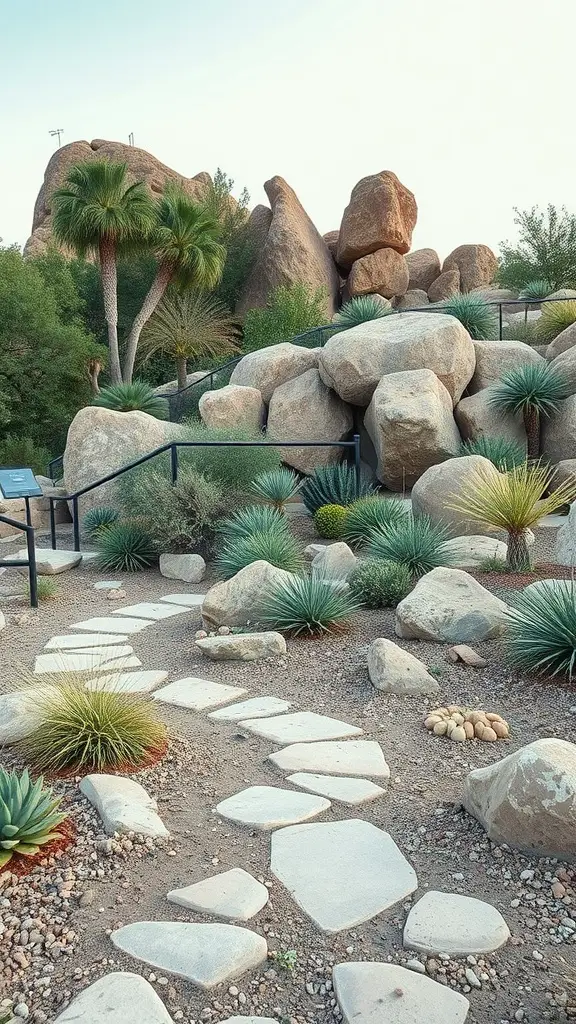
Xeriscaping is a fantastic way to design gardens that require minimal water. The image above beautifully illustrates a xeriscape garden featuring a variety of drought-tolerant plants and a natural stone pathway. This design not only saves water but also enhances the aesthetic appeal of your outdoor space.
The use of large boulders and hardy plants like succulents and palms creates a unique environment that thrives in dry conditions. Notice how the stones are arranged to form a path. This not only guides visitors through the garden but also adds texture and interest.
Incorporating a variety of textures, such as smooth stones and spiky plants, makes the landscape visually engaging. The greenery among the rocks adds a touch of life, showcasing how resilient plants can flourish in low-water areas.
This garden design is an excellent example of how to create an inviting space while being mindful of water usage. By choosing the right plants and materials, you can form a landscape that is both functional and beautiful, perfect for anyone looking to embrace a more sustainable lifestyle.
Selecting Drought-Resistant Trees for Shade

When designing a drought-tolerant landscape, choosing the right trees is essential. The image showcases a striking drought-resistant tree that offers both shade and beauty. Its slender branches spread wide, creating a lovely canopy while casting intriguing shadows on the ground.
These drought-tolerant trees are not just pretty; they are also practical. With their ability to thrive in low-water conditions, they require less maintenance and help conserve precious resources. In warmer climates, they provide welcomed shade, reducing the temperature around your outdoor space.
While selecting a tree, consider its mature size and growth habits. The tree in the image illustrates how a well-placed tree can enhance the landscape while providing relief from the sun. Additionally, trees like this one can attract local wildlife, adding life to your garden.
Overall, opting for drought-resistant trees is a smart move for anyone looking to create a sustainable and visually appealing outdoor area. With the right choices, your garden will flourish while minimizing water use.
Designing with Succulents for Low Maintenance

Succulents are a fantastic choice for any landscape design, especially when you want a low-maintenance option. They come in various shapes, colors, and sizes, making them versatile for any space. The image here showcases an array of succulents, demonstrating how they can create vibrant and lively gardens.
These plants thrive in dry conditions, which makes them perfect for drought-tolerant landscapes. In this image, you can see a delightful mix of textures and colors. The layers of greens, pinks, and yellows create a cheerful and inviting atmosphere.
When designing with succulents, consider grouping them by color or shape for a stunning visual effect. You can mix larger rosette-shaped succulents with smaller, spiky varieties to add depth. Additionally, pairing them with rocks or gravel enhances the natural look and helps with drainage.
Another advantage is that succulents require minimal watering. This feature not only saves you time but also conserves water, making them eco-friendly. Just a little care and the right placement can lead to a flourishing garden.
Designing Terraced Gardens to Prevent Erosion
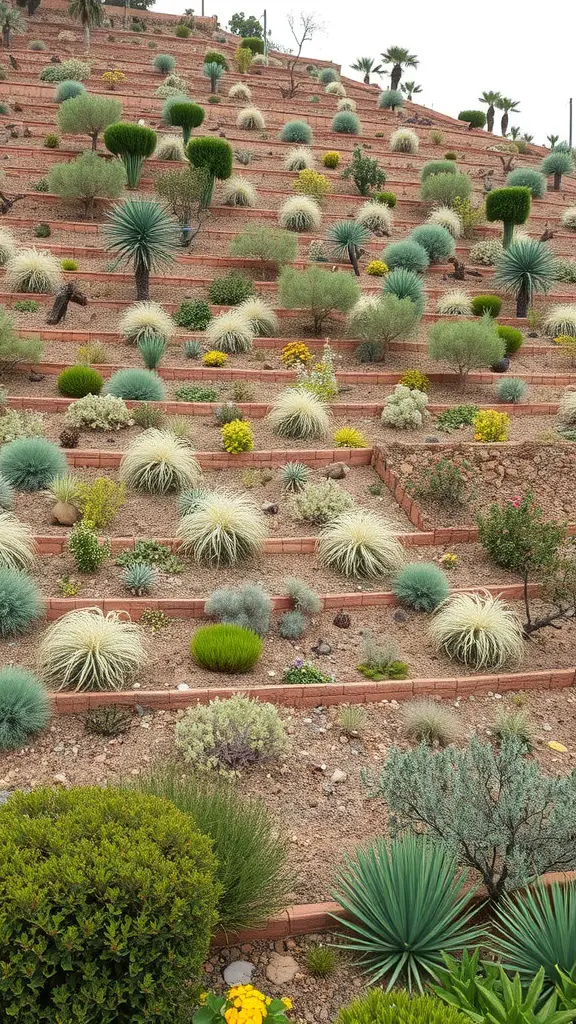
Terraced gardens are a smart way to manage sloped landscapes. In this image, we can see a beautifully designed terraced garden that features a variety of drought-tolerant plants. The steps created by the terraces help to slow down water runoff, which is key in preventing soil erosion.
The use of retaining walls not only adds structure but also defines the planting areas. These walls keep the soil in place, making it easier for the plants to thrive without losing precious nutrients. Notice how the plants are strategically placed—different textures and colors add interest while serving a practical purpose.
In a drought-tolerant landscape, selecting the right plants is crucial. Succulents, cacti, and native shrubs are ideal choices. They require minimal water and can withstand dry conditions. This garden showcases a mix of these plants, creating a stunning visual that also ensures sustainability.
Another key benefit of terracing is that it creates microclimates. Some areas may receive more sunlight or shade, which allows for a diverse range of plants to flourish. This not only enhances the garden’s beauty but also promotes biodiversity.
Overall, incorporating terraced design in your garden not only prevents erosion but also makes your outdoor space more enjoyable and manageable.
Utilizing Drip Irrigation Systems for Efficient Water Use

Drip irrigation systems are a smart choice for anyone looking to create a drought-tolerant landscape. In the image, we see a drip irrigation emitter set up in a garden bed with succulent plants. This method delivers water directly to the roots, ensuring that every drop is used effectively.
These systems are not just efficient; they also help conserve water. By targeting specific plants, you reduce waste and promote healthy growth. The succulent plants in the image thrive with this kind of focused watering, showing how well-suited they are for dry conditions.
Setting up a drip irrigation system can be pretty straightforward. It involves laying out tubing and attaching emitters near each plant. You can easily adjust the flow to meet the needs of different species, making it versatile for any garden design.
Overall, a drip irrigation system complements the concept of drought-tolerant landscaping. It helps maintain a beautiful garden while being mindful of water use. With a little planning and effort, you can enjoy a vibrant landscape that doesn’t compromise on sustainability.
Creating Focal Points with Drought-Tolerant Sculptures
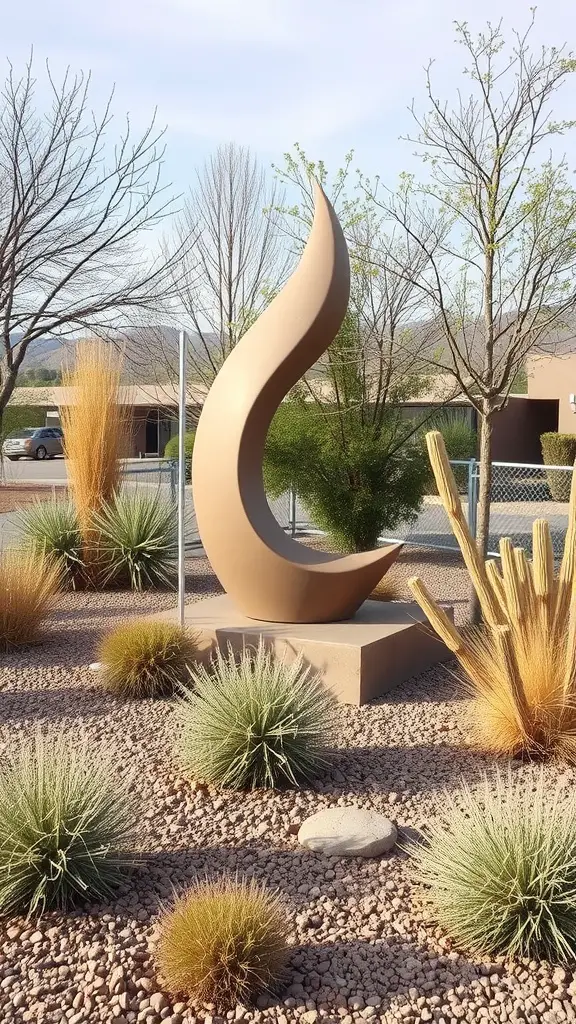
In drought-tolerant landscape design, incorporating sculptures can transform a simple garden into an eye-catching space. The image shows a sleek, modern sculpture that stands proudly amid various drought-resistant plants. Its smooth curves and earthy tones contrast beautifully with the surrounding greenery, creating a stunning focal point.
The use of sculptures adds character and personality to the landscape. They can break up the monotony of plants and gravel, creating visual interest. In this setup, the sculpture’s height draws the eye upwards, leading to a harmonious balance with the low-lying plants around it.
Consider choosing sculptures that reflect your style or themes you want to highlight in your garden. Whether abstract, geometric, or nature-inspired, the right piece can enhance your outdoor space while requiring minimal maintenance.
Incorporating Gravel and Rock Elements for Texture

In drought-tolerant landscape design, using gravel and rock elements can bring a unique texture that enhances the overall aesthetic. The image showcases a winding path made of small gravel stones, bordered by larger rocks and vibrant greenery. This mix of materials not only looks appealing but also serves functional purposes.
The soft curves in the path create a sense of movement and guide visitors through the landscape. The contrast of the smooth gravel against the rough, natural rock formations adds depth to the design. This technique is especially beneficial for water conservation, as gravel helps retain moisture in the soil while minimizing evaporation.
Moreover, incorporating different sizes and colors of rocks can add visual interest. For instance, the use of reddish-brown mulch around the rocks complements the greenery and ties the various elements together beautifully. It’s a simple yet effective way to create a cohesive look in your outdoor space.
Don’t forget to consider native plants that thrive in dry conditions. Pairing these with your gravel and rock elements will not only enhance the beauty of your landscape but will also ensure that it remains sustainable and low-maintenance.
Designing Outdoor Living Spaces with Drought Resistance
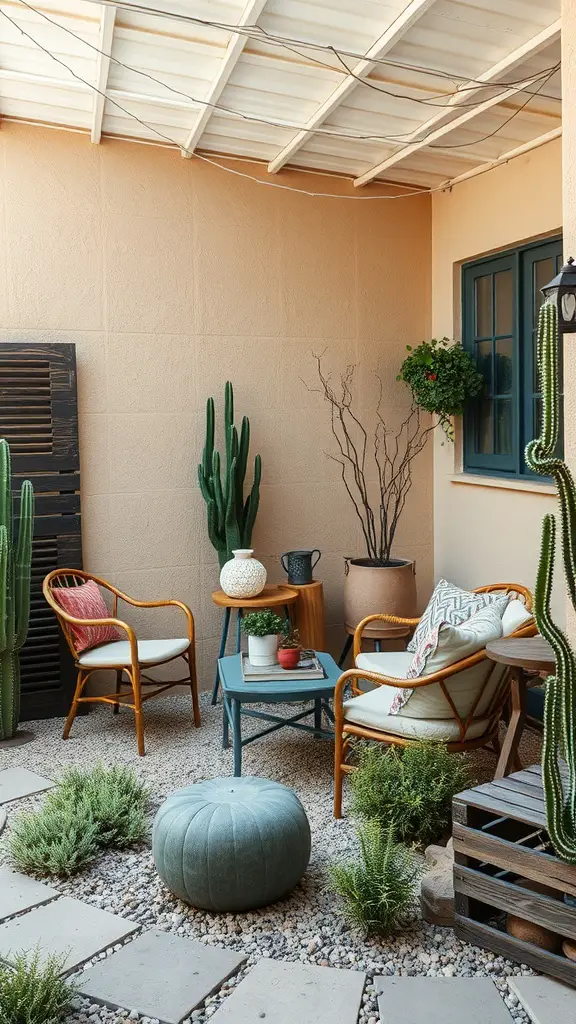
Creating outdoor living spaces that are both inviting and drought-resistant is a smart choice for homeowners looking to minimize water usage while maximizing enjoyment. The image shows a cozy patio area featuring elements that embody this approach.
The space includes comfortable seating options, perfect for relaxing or entertaining. The use of natural materials, like wood and stone, enhances the earthy feel of the design. Notably, the presence of cacti and other drought-tolerant plants not only adds greenery but also contributes to a low-maintenance garden.
The layout of the patio is practical, with a gravel base that allows for good drainage, preventing water from pooling. This is an essential feature in drought-resistant designs. Additionally, the choice of furniture, like the soft pouf and vibrant cushions, brings comfort into the mix without sacrificing style.
Incorporating features such as shaded areas can make outdoor spaces more usable, especially during hot weather. The canopy in the image provides a perfect solution for enjoying the outdoors while staying cool. This combination of comfort and plant choices creates a space that feels both relaxed and sustainable, showing how easily you can blend style with environmental consciousness.
Integrating Edible Plants into Drought-Tolerant Landscapes

Drought-tolerant landscapes can be as colorful and productive as traditional gardens. The image showcases a vibrant collection of plants that not only thrive in dry conditions but can also be part of your meals. Notice the mix of flowering plants and succulents. These types of plants require less water and maintenance, making them ideal for eco-friendly gardens.
Incorporating edible plants like agave or herbs into your design can add flavor to your dishes while keeping your garden sustainable. For example, agaves can be used for their syrup, and vibrant flowers can attract pollinators, benefiting your entire garden ecosystem.
To start, think about what grows well in your climate. Consider planting native herbs, which often thrive in drought scenarios. You can even mix in some colorful flowers to create a striking visual appeal. This approach not only beautifies your space but also provides fresh ingredients right at your fingertips.
Don’t forget to plan for seasonal changes. Some plants may blossom in spring while others might thrive in summer. This will keep your garden lively and productive throughout the year. Embracing edible plants in your drought-tolerant designs opens up a world of flavors and colors that are both practical and delightful.
Using Color Theory in Drought-Tolerant Landscaping

When considering drought-tolerant landscaping, color theory plays a crucial role in creating a vibrant garden. The image showcases a cheerful arrangement of flowers, bursting with colors like orange, purple, yellow, and white. Each hue contributes to the overall aesthetic while also promoting a sense of harmony.
Bright colors attract the eye and can make a garden feel welcoming. In this case, the combination of daisies, blooming succulents, and vibrant daisies creates a lively atmosphere. Drought-resistant plants often have striking colors, which can help enhance the landscape and provide visual interest without requiring excessive water.
Utilizing color contrast is another smart technique. For instance, the deep purple lupines stand out against the warm oranges and yellows, creating a dynamic scene. This not only draws attention but also highlights the unique textures of each plant.
Additionally, grouping plants by color can create a stunning focal point. Imagine a garden where vibrant reds meet sunny yellows, creating a rainbow effect. Such arrangements can make your outdoor space feel more expansive and inviting.
In summary, using color theory in drought-tolerant landscaping not only beautifies your space but also ensures that it remains sustainable. So, whether you’re planting vibrant flowers or unique succulents, remember that the colors you choose can make all the difference.
Implementing Seasonal Plant Rotation for Diversity

When designing a drought-tolerant landscape, seasonal plant rotation is a smart strategy to maintain visual appeal and ecological balance. The image showcases a vibrant mix of drought-resistant plants, highlighting how various colors and textures can work together harmoniously.
By rotating plants with different blooming seasons, you can ensure your garden remains lively throughout the year. For instance, the bright flowers in the foreground, with their cheerful hues, attract pollinators, while the resilient succulents in the background provide structure and contrast.
This approach not only keeps your landscape interesting but also supports local wildlife. Birds, bees, and butterflies all benefit from a diverse planting scheme, making your garden a thriving habitat.
Additionally, seasonal rotation can help manage soil health, as different plants have varying nutrient needs. This minimizes the risk of soil depletion and encourages a more sustainable gardening practice. Mixing in flowering plants with various water requirements can ensure that while some thrive during dry spells, others can step up during wetter periods.
Incorporating Water Features for Artistic Appeal

Water features can bring a unique charm to drought-tolerant landscapes. In the image, we see a lovely pond surrounded by natural stone. The gentle fountain adds movement and sound, creating a soothing atmosphere.
Incorporating such features not only enhances visual appeal but also supports local wildlife. Birds and butterflies are often attracted to water sources, bringing life to your garden. Using rocks and native plants around the pond helps maintain a natural look while conserving water.
When designing your landscape, think about the placement of your water feature. It can serve as a focal point or seamlessly blend into the surrounding flora. Consider the color and texture of your stones, as they can greatly influence the overall vibe.
Overall, adding a water feature can be an artistic way to elevate your drought-tolerant landscape. It offers a space for relaxation while contributing to a balanced ecosystem. So why not explore options that fit your style and budget?
Emphasizing Vertical Gardens to Maximize Space

In drought-tolerant landscape design, vertical gardens stand out as a smart way to use space effectively. The image shows a beautiful wall of lush greenery, featuring various plants that thrive in arid conditions. This kind of setup not only saves ground space but also adds a splash of life to otherwise bare walls.
Vertical gardens are perfect for small areas. They allow you to grow a variety of drought-resistant plants without needing extensive ground coverage. The design seen here showcases an array of greens, yellows, and textures that create visual interest and vibrancy.
Incorporating these gardens is about more than just aesthetics. They contribute to better air quality and help insulate buildings. Plus, the plants shown are hardy and require minimal maintenance, making them ideal for those who want greenery without a lot of fuss.
Adding pots at the base provides even more opportunities to include different species. This layered approach not only enhances the visual appeal but also promotes a diverse ecosystem. For anyone looking to optimize their outdoor space, vertical gardens are a practical and stylish solution.
Creating Pathways with Drought-Resistant Ground Covers

Pathways in a landscape can guide visitors while adding a touch of style. In drought-tolerant designs, using the right materials and plants is essential. The image beautifully captures a serene pathway made of stone slabs, set against a lush backdrop of green foliage.
The ground cover flanking the path is likely a drought-resistant variety. This choice not only enhances the pathway’s aesthetics but also minimizes the need for water. Grasses and low-growing plants thrive in such environments, creating a soft, inviting look.
When designing your own pathways, consider using natural stone or gravel that blends with the surroundings. These materials hold up well under sunlight and require less maintenance. Pair them with resilient ground covers to ensure that your pathway stays vibrant with minimal effort.
Also, think about the overall flow of the space. A meandering path, like the one in the image, invites exploration and connects different areas of your yard. Incorporating drought-tolerant plants along the way can enhance the journey and provide a beautiful backdrop.
Creating Wildlife Habitats with Native Plants

In this vibrant scene, we see a beautiful array of native flowers in full bloom, providing a perfect backdrop for a butterfly in flight. The colorful blossoms not only add charm to the landscape, but they also play a crucial role in supporting local ecosystem health.
Using native plants in landscape design is a simple yet effective way to create wildlife habitats. These plants are naturally adapted to the local climate, requiring less water and maintenance than non-native species. By incorporating them into your garden, you can attract beneficial insects and pollinators like butterflies, bees, and birds.
The butterfly in the image showcases the beauty and vitality that native plants can bring to any outdoor space. When you create a garden filled with these plants, you not only enhance your own enjoyment but also contribute to the sustenance of local wildlife.
So, think about selecting a variety of native flowers that bloom at different times of the year. This approach ensures that your garden remains lively and serves as a food source for wildlife throughout the seasons.
Using Decorative Boulders for Natural Beauty

Decorative boulders can transform a landscape into a serene oasis. In the image, you can see a rugged terrain dotted with various boulders and sparse greenery. This natural look is not only visually appealing but also serves practical purposes.
These large stones provide structure to the garden. They create layers and depth, guiding the eye through the space. The different sizes and shapes of the rocks add character, making the landscape feel more dynamic.
Moreover, they play a crucial role in drought-tolerant design. With limited water availability, boulders help to retain moisture in the soil. They create shaded areas that are beneficial for the surrounding plants. This can ensure that even in dry conditions, your landscape can thrive.
Incorporating these elements is simple. Choose boulders that fit your style and the natural environment. Arrange them thoughtfully among native plants, and you’ll create a beautiful, low-maintenance landscape that enhances the natural beauty of your surroundings.
Designing with Seasonal Interest in Mind

When creating a drought-tolerant landscape, seasonal interest plays a key role in keeping the yard attractive throughout the year. The image showcases a beautifully designed garden that captures this idea perfectly. From vibrant flowers to unique foliage, every element contributes to a lively atmosphere.
The garden features various plants that bloom at different times, ensuring color and texture are present in every season. Bright purple petunias and tall, elegant lilies stand out against the earthy tones of the gravel, creating a pleasing contrast. This mix not only catches the eye but also provides a habitat for pollinators, promoting biodiversity.
Incorporating diverse plant species is crucial when planning for seasonal change. For instance, the spiky silhouettes of succulent plants add interest even when blooms fade. These plants are hardy and need little water, making them perfect for drought-tolerant gardens. The use of rocks and gravel instead of traditional lawns also makes maintenance easier while enhancing the overall aesthetic.
Paths made from stone lead through the garden, creating a sense of exploration. The design invites visitors to wander and enjoy the beauty of nature. By choosing plants that provide visual interest throughout the year, you can create a landscape that is both functional and beautiful.
Xeriscaping Principles for Water Efficiency
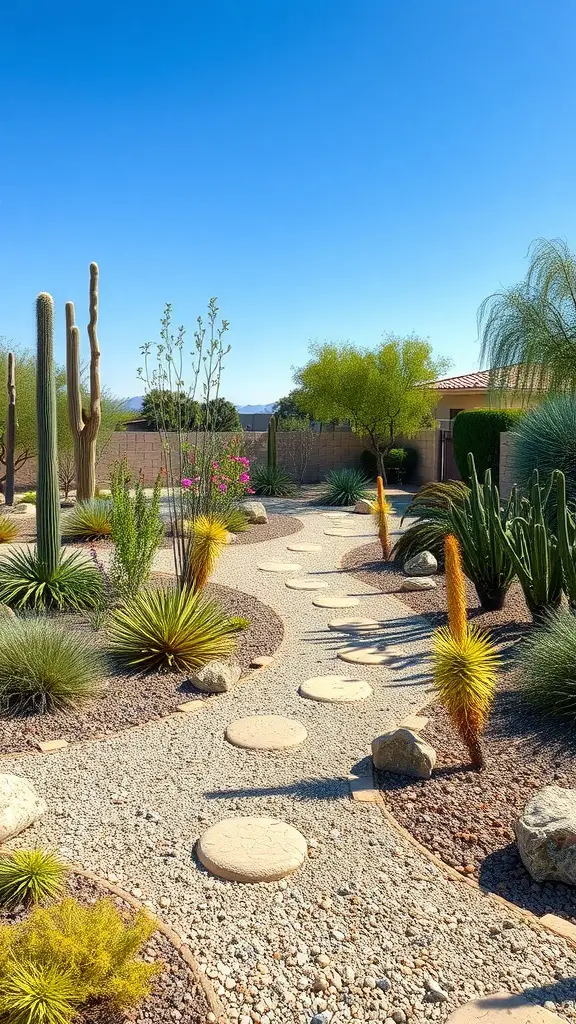
Xeriscaping is all about designing a landscape that uses minimal water. The image shows a well-designed xeriscape garden featuring various drought-tolerant plants and unique stone pathways. Notice how the plants are carefully chosen for their ability to thrive in dry conditions, making the landscape both beautiful and practical.
The winding path creates an inviting atmosphere, encouraging exploration. Using materials like gravel and stones helps retain moisture for the plants while also providing a clean, low-maintenance look. The combination of cacti and vibrant greenery adds texture and color, enhancing the overall aesthetic.
In this landscape design, native plants are prioritized. They require less watering and are better suited to the local climate. This not only saves water but also supports local wildlife. Incorporating rocks and mulch helps reduce evaporation, making this garden both eco-friendly and visually appealing.
Overall, this image captures the essence of xeriscaping, showcasing how careful planning can lead to a sustainable and attractive outdoor space. By following these principles, anyone can create a drought-tolerant landscape that thrives without excessive water usage.



